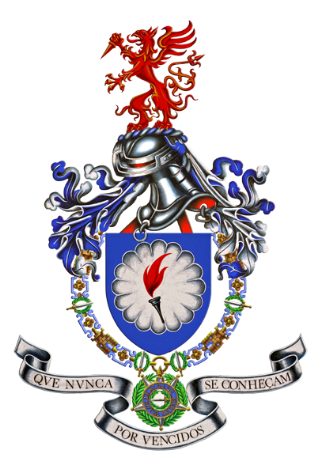
The de Havilland Canada DHC-1 Chipmunk is a tandem, two-seat, single-engined primary trainer aircraft designed and developed by Canadian aircraft manufacturer de Havilland Canada. It was developed shortly after the Second World War and sold in large numbers during the immediate post-war years, being typically employed as a replacement for the de Havilland Tiger Moth biplane.

Raymonde de Laroche was a French pilot, thought to be the first woman to pilot a plane. She became the world's first licensed female pilot on 8 March 1910.

OGMA – Indústria Aeronáutica de Portugal S.A. is a Portuguese aerospace company focused on aircraft maintenance and manufacturing.

The Portuguese Air Force is the aerial warfare force of Portugal. Locally it is referred to by the acronym FAP but internationally is often referred to by the acronym PRTAF. It is the youngest of the three branches of the Portuguese Armed Forces.

The Regimento de Paraquedistas, based in Tancos, Portugal, is a unit of the Portuguese Army and serves as the instruction center for recruitment and training of the Portuguese paratroopers. This unit includes an entire battalion, acting as support and reserve for airborne units which contains for example, military war dogs and airborne pathfinders and an instruction battalion responsible for the forming of new paratroopers.

The Asas de Portugal was a flight demonstration team created in 1977 integrated with Esquadra 103 of the Portuguese Air Force. It was Portugal's national aerobatic flying team and flew two ex-German Air Force Dassault-Breguet/Dornier Alpha Jets.

The Portuguese Paratroop Nurses were a group of 46 women that, between 1961 and 1974, became the first women to be integrated into the Portuguese Armed Forces.
Lauretta M Schimmoler was an aviator who was the first woman in the United States to establish an airport in the United States, the first woman to command an American Legion post and was the founder of the Aerial Nurse Corps of America the predecessor of the flight nurses of the United States Air Force.

The 502 Squadron "Elefantes" is a transport squadron of the Portuguese Air Force. Its primary mission is tactical air transport and has the secondary mission of providing additional pilot training in multi-engine aircraft and in navigation, search and rescue, and general air transport.

The Air Museum is an aviation museum of the Portuguese Air Force located at Sintra Air Base and with spaces at Ovar and Alverca.

The Portuguese Air Force (PoAF) has operated Sud Aviation Alouette III light utility helicopters since 1963. The Portuguese government originally purchased 142 helicopters to replace the Sud Aviation Alouette II and for use in the roles of tactical transport, medical evacuation, and flight training, with several being adopted for combat air support.

The Portuguese Paratroopers are an elite infantry assault force, representing the bulk of the airborne forces of Portugal. They were created in 1956 as part of the Portuguese Air Force, being transferred to the Portuguese Army in 1993. Presently, most of the Paratroopers are part of the Portuguese Rapid Reaction Brigade which comprises all 3 special forces troops.

Ada Rogato was a pioneering woman aviator from Brazil. She broke five records, becoming the first South American woman to earn a glider pilot's license and the first Brazilian woman to earn paratrooper certification. She broke the world record for the longest solo flight, was the first to fly across all three of the Americas and held the Brazilian record for the number of parachute jumps. She was also Brazil's first woman agricultural pilot, flying crop dusters for the Biological Institute to eliminate pests which were destroying the country's coffee crop.

Yvonne Jourjon was a pioneering French pilot and flight instructor; she was the first woman flight instructor in France.

Dália da Cunha-Sammer was a Portuguese gymnast. She competed at the 1952 Summer Olympics and the 1960 Summer Olympics.She is considered one of the pioneers of Portuguese Olympic gymnastics.

Maria de Lourdes Braga de Sá Teixeira was a Portuguese aviator, being the first woman to obtain a pilot’s licence in Portugal, at the age of twenty-one.

Isabel de Magalhães Colaço was a Portuguese lawyer and university professor who was the first woman to obtain a doctorate of law in Portugal and the first woman to sit on the country’s Constitutional Court.
An aircraft category is defined by the International Civil Aviation Organization as a "classification of aircraft according to specified basic characteristics", for the purpose of personnel licensing. Examples of aircraft categories include aeroplanes, helicopters, gliders, or free balloons.

Stefania Cecylia Wojtulanis-Karpińska, was a Polish aviator. She was a sports pilot in the inter war period and was a Captain in the Polish Air Force. She flew in the British Air Transport Auxiliary during the Second World War, when she was known as Barbara Wojtulanis. She was one of the first two Polish woman pilots to join the British Air Transport Auxiliary, the other being Anna Leska.

















